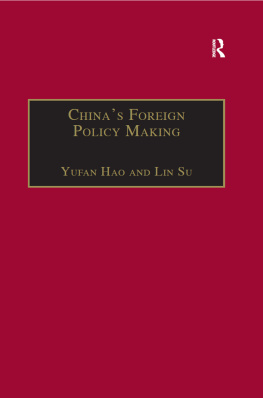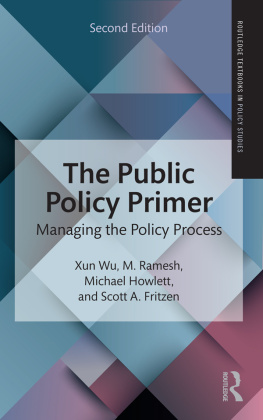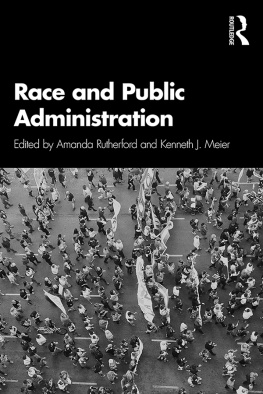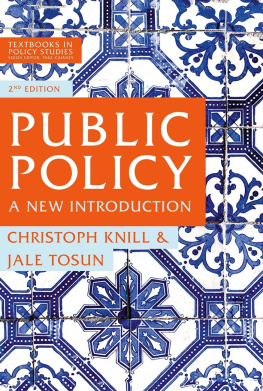
Public
Policymaking
An Introduction
SEVENTH EDITION
JAMES E. ANDERSON
Texas A&M University
Australia Brazil Japan Korea Mexico Singapore Spain United Kingdom United States
Public Policymaking: An Introduction,
2011, 2006, 2003 Wadsworth, Cengage Learning
Seventh Edition
ALL RIGHTS RESERVED. No part of this work covered by the
James E. Anderson
copyright herein may be reproduced, transmitted, stored, or
Senior Publisher: Suzanne Jeans
used in any form or by any means graphic, electronic, or
Executive Editor: Carolyn Merrill
mechanical, including but not limited to photocopying,
Acquisitions Editor: Edwin Hill
recording, scanning, digitizing, taping, Web distribution,
information networks, or information storage and retrieval
Development Editor: Thomas Finn
systems, except as permitted under Section 107 or 108 of the Assistant Editor: Kate MacLean
1976 United States Copyright Act, without the prior written
Editorial Assistant: Matthew DiGangi
permission of the publisher.
Media Editor: Caitlin Holroyd
Senior Marketing Manager: Amy Whitaker
For product information and
Marketing Coordinator: Josh Hendrick
technology assistance, contact us at Cengage Learning
Customer & Sales Support, 1-800-354-9706
Marketing Communications Manager:
For permission to use material from this text or product,
Heather Baxley
submit all requests online at www.cengage.com/permissions.
Associate Content Project Manager: Sara
Further permissions questions can be emailed to
Abbott
permissionrequest@cengage.com.
Art Director: Linda Helcher
Print Buyer: Paula Vang
Library of Congress Catalog Card Number: 2009932921
ISBN-13: 978-0-618-97472-6
Senior Rights Acquisition Account Manager,
ISBN-10: 0-618-97472-5
Text: Katie Huha
Production Service: Elm Street Publishing
Services
Wadsworth
Cover Designer: Paul Neff
20 Channel Center Street
Boston, MA 02210
Cover Image: Photomorphic
USA
Compositor: Integra Software
Services Pvt. Ltd.
Cengage Learning is a leading provider of customized
learning solutions with office locations around the globe,
including Singapore, the United Kingdom, Australia,
Mexico, Brazil and Japan. Locate your local office at
international.cengage.com/region
Cengage Learning products are represented in Canada by
Nelson Education, Ltd.
For your course and learning solutions, visit
www.cengage.com.
Purchase any of our products at your local college store
or at our preferred online store www.ichapters.com.
Printed in the United States of America
1 2 3 4 5 6 7 13 12 11 10 09
Contents
iv
Contents
Contents
v
This page intentionally left blank
In Public Policymaking: An Introduction, Seventh Edition, the policymaking process is presented as a policy cyclea sequence of functional activities beginning with problem identification and agenda formation, and concluding with the evaluation and the continuation, modification, or termination of policy. This policy cycle schema is a workable approach to the study and analysis of public policymaking, whether in the United States or elsewhere. In addition, the text looks at some other approaches to the study of policy formation; describes and analyzes the political environment of policymaking in the United States; makes comparisons with other countries; and examines some of the logistical aspects of policymaking, such as majority building, cost-benefit analysis, and decision-making.
In the years since the sixth edition of this book was published, various note-worthy changes have occurred in government and public policy. The housing bubble burst and a major economic recession, along with a financial crisis, set in. National budget deficits have swelled, and the national debt has mush-roomed. The long war in Iraq appears to be winding down as the war in Afghanistan is heating up.
The George W. Bush administration, which displayed a governing style and policy positions that differed greatly from those of the predecessor Clinton administration, has departed from Washington. In its place is the Barack Obama administration, whose policy preferences and actions are much more liberal and interventionist than those of President Bush and his people.
Moreover, the Democratic Party has gained control of both Houses of Congress. The political pendulum has taken a leftward swing. Though current events is not my major concern, these and other matters have been considered in revising and updating this book.
The American system continues to demonstrate resilience and the capacity to temper and mitigate change. Policies have been changed, but the fundamental structure of the policymaking process remains as before. As a result, the texts approach to policymaking remains fully relevant to the current field of study.
As the subtitle indicates, Public Policymaking: An Introduction serves as a jumping-off point for the study of public policymaking by touching upon all stages or phases of the policymaking process. In addition, for those who want to explore these stages more deeply, the suggested readings and websites listed at the end of each chapter will be helpful.
While I certainly have my own opinions on policy and politics, I try to be even-handed and impartial in my handling of the many topics covered in this book.
I have been guided, and I think with considerable success, by the principle of viii
Preface
intended neutrality in writing this book. Analysis rather than advocacy and teaching rather than preaching have been my goals.
Organization and Updates
I have made a variety of changes and additions, and a few deletions, in this revision, taking into account new developments in policymaking, particularly at the national level in the United States. I have also been influenced by recent additions to the scholarly literature on public policy formation. The basic framework of the book, however, remains intact. In the initial chapter I have restructured the discussion of categories of public policy. Constituent policy is a new feature.
The chapter titled The Policy-Makers and Their Environment surveys the political environment, or context of policymaking, and presents the official and unofficial participants in the policy process. Many minor changes have been made along with the addition of material on Congress and the Supreme Court and presidential action.
Policy Formation: Problems, Agendas, and Formulation, examines policy problems and agendas, agenda-setting processes, and the formulation of policy proposals. These are the pre-adoption aspects of the policy cycle. Material has been added on problems, agenda-setting, and formulation.
The chapter Policy Adoption centers on decision-making and the adoption of policies. Science is added to the decision criteria section. There is a new case study on the Economic Stimulus Act. It stands in contrast to the bankruptcy study, which has been updated.
The Budgeting and Public Policy chapter deals with the national budgetary process because of its importance for the implementation and substance of policy. A new section on fiscal policy is included, the discussion of congressional decision-making is expanded, and the struggle for a balanced budget (a losing venture, it seems) has been updated.
Policy Implementation covers much territory in surveying the implementation or administration of policy. The discussion of federal aid to education, including the No Child Left Behind Act has been consolidated, voluntary regulation has been added as a implementation technique, and there are new case studies on nuclear waste disposal and water pollution control.
Next page









